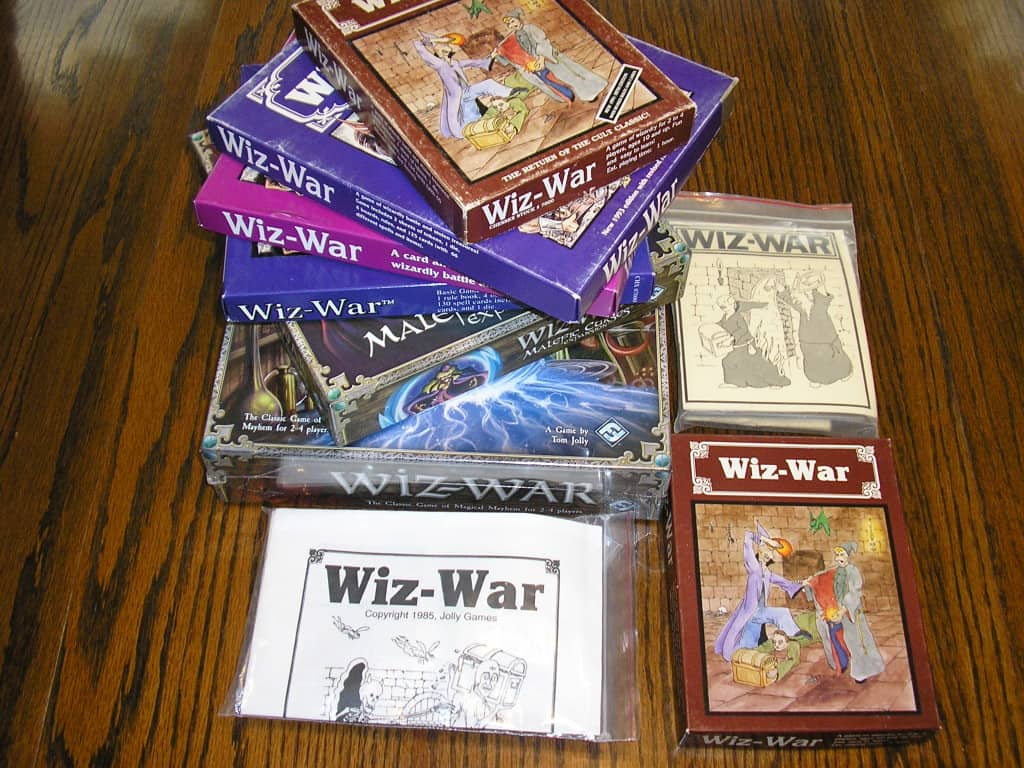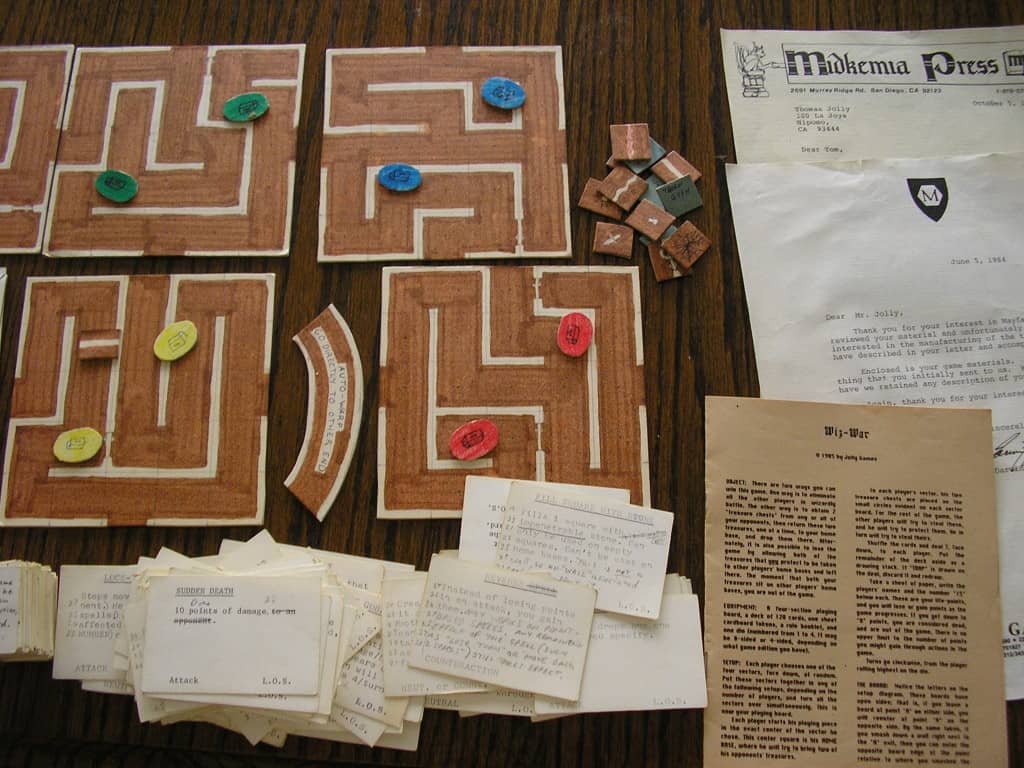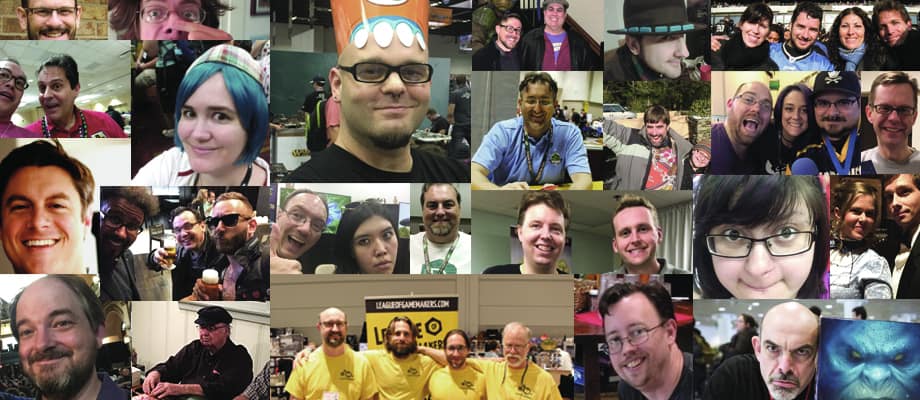
Wiz-War was, as far as I can remember, the first actual game that I tried to design. Since this was in 1983, I would have been 29 years old. The game has seen 8 editions since then, going through Jolly Games, Chessex, and Fantasy Flight Games.
When Wiz-War was first designed, with help from my good friends Jeff Smith (now deceased) and David Johnson as playtesters, it was considerably different from the first published version. In one version, the players were running around the maze-like board (one, not four), and whenever they reached an “oracle”, they could draw 2 new cards. It wasn’t particularly good. It resolved itself into the four board, draw-2-cards-every-turn version in fairly short order.
In 1983, I submitted it for publication to Midkemia Press (with a little encouragement by Ray Feist, the author, who had played the prototype at the first Polycon in San Luis Obispo the same year). It was rejected by Steve Abrams with some encouraging comments. In 1984, I submitted it to Mayfair with the same results, and to Steve Jackson Games (who had just starting printing GURPS, since The Fantasy Trip was still owned by Metagaming, a story that Steve could tell), and to Eon Games (of Cosmic Encounters fame). All rejects. Polite, but rejected. This was an interesting development period, though; every time I got the game back from someone, I changed it.
I had faith in the game, however, so I foolishly decided to make it myself.
SELF-PUBLISHING WIZ-WAR
So….1985. Home personal computers were still outrageously expensive. A decent printer was a black-and-white dot-matrix printer where you could pretty much count the dots in each letter. Text paste-ups were done on a typewriter – word processors weren’t in wide use yet. No graphics programs. A color copy at the local printer could be had for $1 per sheet, but that’s 1985 dollars, so that would be like paying $6-7 for a color 8.5×11 now. It wasn’t a realistic option for manufacturing.
My wife Penny and I were living in a doublewide mobile – our first actual purchase of a home, sort of. I ended up hand-silk-screening the first 100 Wiz-War boards after teaching myself the craft (poorly), because that was the cheapest way to produce color. And I did it in my living room. The cards were all done with a typewriter, then cut out and pasted onto an 11×17 sheet. One card-back was made with line-art tape then Xeroxed, cut out, and pasted up on another 11×17, then finally the whole lot was printed out. Oh, of course the rules were all done on a Selectric typewriter too.
I’d like to say:
I CARRIED IT ALL DOWN TO THE PRINTERS ON MY BACK, TEN MILES, BAREFOOT IN THE SNOW
…like we always did in the old days, but it wasn’t quite that bad.
Anyway, this edition of 100 copies came out in 1985 in a zip-locked baggie. A labor of love! I sold most of them quickly at the 1985 Polycon and realized that if I wanted to sell these through stores, I needed a box. Back in 1985, stores weren’t quite so picky about what they were selling (there were a lot of things in zip-locks back then, and graphics weren’t very high quality, in general). Being an artist of very mediocre talent, I painted the so-called artwork that would appear on the next four editions (the “brown box”). It was silly art to go with a beer-and-pretzels game.1 A local printer did the color separations and printed the cover sheet for the box. A box maker in Los Angeles took those sheets and pasted them onto chipboard boxes. I had 2000 made. To keep costs and risk down, I only had 500 sheets made for the boards, and 500 decks printed, of 125 cards each. I paid a decent amount of money for a die for die-cutting tokens.
The decks were hand-collated. If you’ve ever sorted out 125 cards 500 times, you will know that this hurts your back. A lot. I used to pay my kids 10 cents a deck to do this drudgery (and to playtest games – they got paid a bonus if they won). The cards continued to be hand-collated for the next 5 editions and expansions. More on that.
I also bought a roll of shrink-wrap, a bar sealer, and a heat gun to seal up all those little decks and the final box.
This edition, technically the Second Edition (though I don’t think the rules were labeled as such, back when I didn’t think there would be any other editions) was printed on card stock that you could, in the right light, see through. The second and third editions used the same box from the lot of 2000 I printed. The fourth edition print run, I upgraded the card stock so you couldn’t see through it in any sort of light. The 3rd edition rules were on a light yellowish paper with printing that looks like dot-matrix printing. The inside back of the rules say nothing about the edition number. I also printed part of the fourth edition with the same paper, so in fact the 4th ed has two different rule printings (the second by Chessex). The 4th edition actually says “4th edition” in the rules.
During this period, I was taking Wiz-War to various conventions; Strategicon and Origins in LA and Dundracon and Slug-A-Thon in the Bay Area, bumming sales space from friends who also had product and were willing to take a cut of my sales for their trouble. Wiz-War was selling for $10, and the first expansion set was $5. Generally, I could sell two dozen copies of the base game at every con – unusually high for most games. It finally caught the eye of Don Reents of Chessex (also owner of Berkeley Game Distributors at the time), who offered to license the game from me.
CHESSEX LICENSES WIZ-WAR
Their first printing was the fourth edition. Same box, same everything, all they did was put the Chessex stock number on the back-sheet of the game (a sheet which is normally tossed) and reprint the rules. I can’t remember if they took my remaining stock for the 4th edition and sold them, or made their own. There was, obviously, some leakage between the editions.
During this period, I also created the 1st Expansion Set in 1988 (and 1991), and the 2nd Expansion in 1993. Both in zip-locks, both with cheesy art by yours truly. If I remember right, neither of these had die-cut tokens. To save money, I left it to the buyer and his scissors, since both expansions were fairly small print runs (about 500 copies) and I couldn’t absorb the cost of a die.
In addition, I started adhering the token/board sheets for the expansions to chipboard using cans of 3M’s Super 77 spray adhesive. In my garage. So for those of you out there who have used this stuff, it freaking sticks to everything. After a very short while, finding that an aerosol glue will make every surface tacky within about 20 feet of where it’s being sprayed, I made a box out of cardboard with a clear plastic lid and a hole for my arm to fit through. A little pedestal in the middle of the box supported the chipboard I was spraying, and a little cardboard flap let me take the boards in and out. If you can imagine it, the layers of glue built up inside this little toxic spray booth that was about 2” thick. After a session of spraying, my excessively hirsute arm would come out with a white coat of glue on it (didn’t occur to me to wear disposable gloves – if they existed back then). That was a pleasure to get off. I have no idea how badly this screwed up my lungs, though judging by the lack of tacky surfaces in the garage, I was successful in my efforts to isolate the scourge of airborne adhesive.
I must have used a case of that spray-glue:
SUPER 77 IS GREAT STUFF. I STILL USE IT WHEN I WANT TWO PAPER SURFACES TO NEVER, EVER COME APART.
End of advertisement. Probably bad for the environment anyway.
An aside; the expansion sets were built extensively on the spells provided by fans who sent me lists. Both Chessex and Jolly Games sold packs of blank cards where you could create your own spells, and people did. At least one guy (hi, Shawn!) created such a voluminous pile of spells that it measured about 3-4” tall when he played his version of the game. Most of them were absolutely insane spells; I dread to think of what would have occurred if he’d thought to add a foldout sheet of paper to each card. He wore out a couple of copies of Wiz-War playing them incessantly; I’ve never seen such a frayed deck. Anyway, thanks, Shawn (and thanks to all the other players who added spells to the game).
Chessex printed essentially the same version for the 5th edition. About 2000 copies, I think. They put on the cover “New 1991 Fifth Edition” so it’s one of the easiest to identify. And the back was actually a printed box! I was still selling the expansions myself at this time.
Chessex then brought out the 6th edition will all new art from Phil Morrissey in 1993 in a bigger blue box, and the 1st expansion shortly thereafter in a purple box – not sure about the year.2 They sold these out, maybe another 2000 copies, and went to the 7th edition in 1997 which they labeled on the cover as the “Classic Edition” to cover the fact that they hadn’t come out with the deluxe edition that they wanted to come out with.
The 6th or 7th edition (I don’t remember which) had a little problem; Chessex had had them manufactured in Mexico, and 1 out of 12 copies (roughly) had miscounted cards and fingerprints on some of them. I ended up making a guarantee to folks to send them whatever replacement cards they needed, and actually bought quite a few copies from Chessex, opened them up, checked the decks, and resealed everything so I could sell them with confidence. It was an aggravating period.
I still send out replacement parts on occasion (no charge), if I still have them. There are a lot of old bits and pieces from prior editions taking up space in the garage.
THE 10 YEAR PRINT CONTRACT AND A VIDEO GAME CONTRACT
And now we enter a weird period. Around the year 2000, Chessex entered into a 10-year contract with me. They shortly ran out of the 7th edition and started promising to print a deluxe edition (color cards and nice graphics), but it never actually came out. They had contracted with a couple of different artists at different times, and the artwork was complete at least once, but it still never came out. I was ready and willing for any version, even just a reprint of the old version, to come out. I never really understood the behind-the-scenes reason for the lengthy hiatus.
During this same period, I entered into a number of contracts with programmers and video game companies to do a video game version of Wiz-War. Usually very little came out of this. There was a free peer-to-peer version that I never actually saw. There was the version Total Entertainment Network produced, but never actually paid for. And there was Codefire. Codefire was a little video game company in Irvine, California who had aspirations of making, essentially, a first-person shooter game out of Wiz-War. I saw some of the early 3D graphics for the game (fireballs blasting down the hallway) and it looked awesome! They wanted to buy all the rights to Wiz-War for what was, at the time, a very substantial chunk of money, but of course the board game rights were still tied up with Chessex. The three of us met (Michael Williams, Don, and I) and Michael said something that has stuck with me ever since, clarifying the distance between the board game and video game industry. He told Don that he could buy the entire paper print run that Don was going to make and “give them out as promotional material for the video game”. An ad prop for the video game! That was the difference in potential income for the two industries.
But, the OTHER difference between the two industries is this; we entered into the contract, I got my advance, and a few months later Codefire went out of business (not because of my advance, really). The rights for the game reverted back to me (something you should always have in your contracts!). Start-up video game companies, I found out, often have very short life expectancies.
FANTASY FLIGHT GAMES AND THE 8TH EDITION
Returning to the board game; it remained in limbo for over 9 years. During this same period, a few companies asked me if the rights were available; they noticed that it had been “out-of-print” for quite a while. At this point, I had a long working relationship with Fantasy Flight Games, whom I met in Essen, Germany around 1998, and who had subsequently published Diskwars, Vortex, Cavetroll and Drakon. I wanted to go with them as the next publisher. But the contract hadn’t expired with Chessex.
The three of us finally cut a deal prior to the expiration of the Chessex contract (2010) and FFG started to work on the 8th edition. I sent them a list of about 350 cards, including the never-ever published 3rd expansion set (which had Magic Beans! Woo-hoo!). They did an exemplary job on the graphics, as is their reputation, with some changes to the rules and the very chaotic, imbalanced nature of the original deck, and the latest version of Wiz-War was born in 2012, followed by the Malefic Curses expansion in 2013, and the soon-to-be-released (and most awesome!) Bestial Forces for 2014, which adds things to the game I never even thought of.
THE REST, AS THEY SAY, IS HISTORY. OR WILL BE, AFTER IT HAPPENS.
****************
ADDITIONAL NOTES
1. I sold the artwork for the brown-box cover for $20 to Bryce Nakagawa a long time ago, but always regretted that. Jokingly, each time I’d run into him, I’d offer him $25 to buy it back, and he never gave in. I should have kept my mouth shut and been happy it had found a home; a couple of years ago, the artwork appeared in my mail, a gift from Bryce. I was dumbfounded. Thanks again, Bryce.
2. At a convention in Santa Maria (Conquest), I had a few copies of Chessex’s expansion #1 with me that were all stolen. These were the only ones I owned. For about ten years, I had no copy of my expansion set, but stumbled across one on BGG that I tried to buy. As I recollect, the person insisted on giving it to me for free. Thanks, person whose name I don’t remember!









